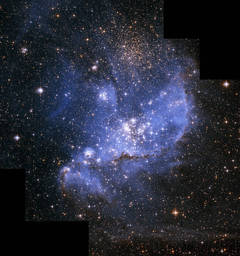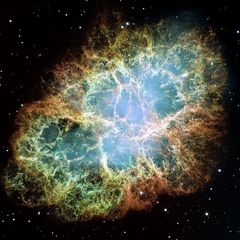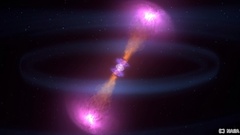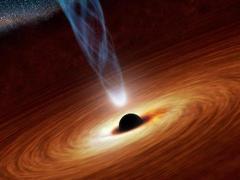05/23/2018
On May 23rd at Nagoya University there was a public lecture titled "Exploring Space That Can't be Seen With Light," that talked about the current state of space observation and its future. The lecturer was Takaaki Kajita, discoverer of neutrino oscillation and winner of the 2015 Nobel Prize in Physics.
As part of an international conference, people from all backgrounds were in attendance. In addition to the physics students, there were also high school students, people from the general public, and people from foreign countries.
This lecture drew special attention from people interested in space, as not only was it being giving by the Nobel Prize winner Takaaki Kajita, but also because he talked about gravitational waves, which have become a hot topic in recent years.
What exactly is "space that can't be seen with light?"
I'll attempt to simplify the contents of the lecture.
If it can't be seen with light, what can it be seen with?
For starters, "space that can't be seen with light" is a concept that was discovered about 100 years ago. At that time, radiation that was believed to come up from the ground was actually discovered to come from the sky. This was the first discovery of cosmic rays, and the first time that humans discovered a high-energy phenomenon that can't be seen with light.
The title of the lecture, "Exploring Space That Can't be Seen With Light" might confuse a lot of people, because if you can't see something with light, what can you see it with?
Actually, the answer is multifaceted. Within this lecture, neutrino/gamma rays, cosmic rays, and gravitational waves were all explored as points of interest.
Let's examine the overviews of each.
Exploring the mysteries of supernovae with neutrinos
Neutrinos are subatomic particles that don't carry an electrical charge. As the name "subatomic particle" suggests, neutrinos are much smaller than atoms, protons, or neutrons and can pass through matter. They can even pass through the sun and the earth. By the way, the "neutrino oscillation" discovery that I mentioned in the beginning was made possible by using the phase property of neutrinos and examining them before and after they pass through an object.
Many neutrinos are given off during a supernova explosion.
A supernova explosion is what happens when a star, many times more massive than our sun, reaches the end of its life and explodes. This explosion releases and unimaginable amount of energy (when a single star goes supernova, it grows as bright as all the billions of stars in the galaxy). As a result, even stars that are normally too dim to be seen with the naked eye can give the appearance that a new star has formed in that spot when they go supernova. This is the origin behind the word "supernova;" with "nova" meaning "new" in Latin.
The supernova explosion, which marks the end of a star's life, is a major subject of physics research, and is still shrouded in mystery. At the Super-Kamiokande, a famous neutrino observatory in Gifu Prefecture, scientists are hard at work uncovering the mechanism in supernovae that releases large amounts of neutrinos.
In order to catch neutrinos released from supernovae in the past, researchers are currently working on improving the equipment. They expect to have everything running by next year.
The photo above is referred to as the "remains of a supernova," and is a photo of a spot where a supernova explosion occurred approximately 1,000 years ago. In fact, this event was recorded by Fujiwara no Teika in his Meigetsuki, where he describes the "new" star as the "Guest Star."
It is thought that within the remains of a supernova, cosmic rays (made of high energy particles) are being accelerated. However, the paths of cosmic rays are often altered by the variety of astronomical objects that possess magnetic fields. As a result, it is impossible to tell where cosmic rays came from just by observation.
Here's where gamma rays come in.
Where do cosmic rays come from? The mystery of space seen through gamma rays
What we call electromagnetic waves depends on how much energy they have. What we see as visible light is also a form of electromagnetic waves. Electromagnetic waves with the most energy are called gamma rays.
Within gamma rays there exist "high-energy gamma rays," which are electromagnetic waves with extremely high amounts of energy that were given off at the beginning of the universe when high-energy protons and atoms collided with other particles.
Where do cosmic rays come from? The answer is not so simple, as cosmic rays are warped by magnetic fields that exist in space.
What about gamma rays? As I said before, gamma rays are electromagnetic waves. The paths of electromagnetic waves aren't warped by magnetic fields. Magnets don't bend the light that you see, just as the magnetic field of our sun doesn't bend the light it gives off. By observing them with gamma rays, it is then possible to determine where the progenitors of cosmic rays, protons and neutrons, are being accelerated.
Actually, after analyzing the data from the remains of the supernova, researchers were able to find high-energy gamma rays. Consequently, this discovery established decisive evidence suggesting that cosmic rays originate somewhere within the remains of supernovae.
High-energy gamma rays can come from other high-energy astrological objects as well, including the super-massive black hole at the center of the Milky Way, neutron stars, and gamma ray bursts (the photo above is an illustration of a gamma ray burst).
Observing high-energy cosmic rays
Earlier I wrote that magnetic fields bend cosmic rays.
However, there are rare high-energy cosmic rays that can pass through magnetic fields unaffected. These are called "extreme-energy cosmic rays" (EECR). One EECR particle has roughly the same energy as a baseball thrown by a professional pitcher. Just one particle has that much energy.
This energy is about 10,000,000 times more than the high-energy particles scientists can create in a lab by adding energy to a particle.
It is still uncertain where these extraordinarily high-energy cosmic rays come from. Although, as such high-energy cosmic rays are so rare, it is difficult to observe them.
EECR are so rare that even if you had a device as big as Nagoya University's Higashiyama Campus (about 700,000㎡, or 15 Tokyo Domes in area) to detect them, it would take about 1,000 years of continuous observation to just catch one or two particles!
There are 700㎢-wide and 3000㎢-wide facilities in Utah and Argentina, respectively, just for observing EECR. From the observations, it was suggested that EECR are being created within the center of a nearby active galaxy, but further observation is necessary.
When space-time warping super-massive black holes collide
Gravitational waves seen at last
Albert Einstein, the physicist famous for his Theory of Relativity, theorized that, "When heavy objects move, they should create waves of gravity that expand and contract within a vacuum." These are gravitational waves.
Things don't get much heavier than black holes. In 2016, the first directly observed gravitational waves were a result of the collision of two black holes. When that happened, the mass of 3 solar masses was turned into energy via gravitational waves. More specifically, the energy of the gravitational wave was 10 billion, trillion times all of the energy the sun releases in an instant. This amount of energy far outpaces a supernova, and is roughly equivalent to all of the energy all of the stars in the universe release in a second.
This gravitational wave could be observed because of its interfering property with light. This interference can be thought of 2 lights overlapping to create an even stronger light. Gravitational waves can be detected by the variation in light intensity, caused by interference when space expands and contracts as a result of the wave.
Scientists think that gravitational waves are formed by collisions between black holes and neutron stars, as well as when stars go supernova. By continuing to observe gravitational waves it is possible that we could uncover the mysteries behind the development of super-massive black holes and the formation of rare metals, like gold and platinum, along with other heavy metallic elements.
In Japan too, the development of KAGRA, a gravitational wave telescope that uses a laser interferometer, is underway. Once it turns on, KAGRA will be the world's most precise gravitational wave telescope. It is scheduled for a test run this year, and is expected to start observations in 2019. When KAGRA begins operation it will be able to link up with other gravitational wave telescopes, making it possible to identify the origins of gravitational waves. The course of its development is being watched closely, as the start of KAGRA has even been called "The Start of Gravitational Wave Astronomy."
****
As the lecture was directed at an audience of high school age or older, its contents were actually quite easy to understand. I even heard a few physics students complaining that the lecture was too simple. Some of you reading this article might think that it's plenty difficult, but within the physics department, second year students are already taking courses more difficult than this.
In the Nagoya University School of Science, not only will you be able to understand lectures like this one, you will also be able to learn in much more detail. Even if you have just a little interest in space, you should stop by the Nagoya University School of Science.
Reported by Satoya Nakano (Japan)
(Modified and Translated by the Public Relations Office, Nagoya University)






